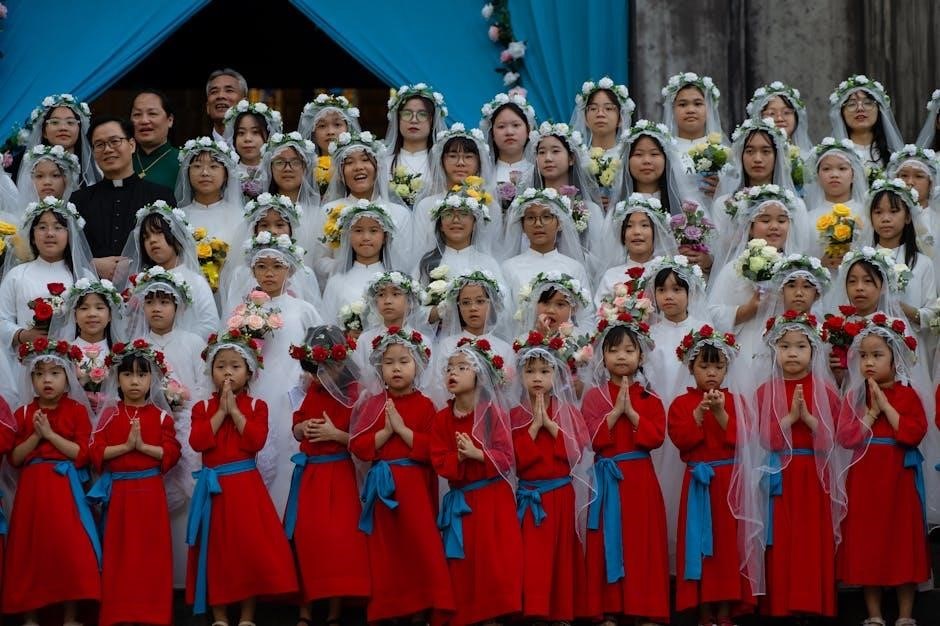The Prayer of St; Francis is a timeless plea for peace‚ love‚ and reconciliation‚ attributed to the 13th-century saint. Its universal message transcends faith‚ inspiring global devotion.

Overview of the Prayer
The Prayer of St. Francis is a heartfelt invocation for peace‚ compassion‚ and unity‚ widely attributed to the 13th-century saint. It begins with a plea to become an “instrument of your peace‚” seeking to replace hatred with love‚ injury with pardon‚ and doubt with faith. The prayer emphasizes humility‚ selflessness‚ and devotion‚ reflecting St. Francis’ commitment to living a simple‚ Christ-like life. Its universal message resonates across faiths and cultures‚ making it a popular choice for worship‚ reflection‚ and inspiration. While its exact authorship is debated‚ the prayer’s enduring relevance lies in its call to action for personal transformation and global harmony‚ inspiring countless adaptations in music‚ art‚ and literature.
Significance of the Prayer in Modern Times
The Prayer of St. Francis holds profound significance in modern times‚ offering a timeless message of peace‚ love‚ and reconciliation. Its universal appeal transcends religious boundaries‚ making it a powerful tool for fostering unity and compassion in a divided world. The prayer’s emphasis on humility‚ forgiveness‚ and selflessness resonates deeply in contemporary society‚ where conflict and division often prevail. It is widely used in worship services‚ peace initiatives‚ and personal devotion‚ inspiring individuals to strive for inner transformation and global harmony. Its adaptation into music‚ art‚ and literature further amplifies its reach‚ ensuring its relevance in addressing modern challenges. As a symbol of hope‚ the prayer continues to inspire interfaith dialogue and promote peace in troubled times‚ making it a cherished spiritual resource for people worldwide.

Structure and Composition of the Prayer
The Prayer of St. Francis is structured as a series of requests‚ seeking divine guidance to embody peace‚ love‚ and compassion. Its lyrical style and repetitive phrasing create a meditative rhythm‚ making it memorable and suitable for recitation or song.
Key Themes and Messages
The Prayer of St. Francis emphasizes themes of peace‚ love‚ forgiveness‚ and faith. It calls for sowing love where there is hatred‚ offering pardon for injury‚ and fostering faith in times of doubt. The prayer also highlights hope in despair‚ light in darkness‚ and joy in sorrow. It encourages believers to console others rather than seek consolation and to understand rather than be understood. The prayer’s central message is selflessness and compassion‚ urging individuals to embody peace and reconciliation. Its universal appeal lies in its timeless wisdom‚ inspiring personal transformation and a commitment to serving others. These themes resonate across cultures and faiths‚ making the prayer a powerful tool for spiritual growth and global unity.
Literary Style and Language
The Prayer of St. Francis is renowned for its simple yet profound literary style‚ characterized by poetic and contemplative language. Its structure is rhythmic‚ with a series of parallel phrases that create a sense of flow and harmony. The prayer employs antithesis‚ contrasting hatred with love‚ injury with pardon‚ and doubt with faith‚ emphasizing the transformative power of divine grace. The language is humble and direct‚ reflecting St. Francis’s devotion to a life of selflessness and compassion. Rich in imagery‚ the prayer contrasts darkness with light and sorrow with joy‚ offering a vision of hope and reconciliation. Its literary beauty lies in its ability to inspire reflection and action‚ making it a timeless and universal spiritual text.
Divine Master‚ Grant That I May Not So Much Seek…
The phrase “Divine Master‚ grant that I may not so much seek to be consoled as to console‚ to be understood as to understand‚ to be loved as to love” embodies the essence of selflessness and compassion. This section of the prayer reflects St. Francis’s deep commitment to humility and service. It emphasizes the importance of prioritizing others’ needs over one’s own‚ fostering a spirit of empathy and sacrifice. The language here is deeply personal‚ inviting the believer to embrace a life of giving and understanding. This part of the prayer is often seen as a call to action‚ encouraging followers to live out their faith through acts of love and kindness‚ aligning with the broader themes of peace and reconciliation found throughout the prayer;

Authorship and Historical Context
The Prayer of St. Francis is traditionally attributed to St. Francis of Assisi‚ though its exact origin remains uncertain. It gained popularity post-World War II.
St. Francis of Assisi: A Brief Biography
St. Francis of Assisi (1181–1226) was an Italian Catholic friar and preacher. Born into a wealthy merchant family‚ he lived a life of luxury before experiencing a profound spiritual awakening. Renouncing his wealth‚ he embraced a life of poverty and devotion to God. Francis founded the Franciscan Order‚ emphasizing simplicity‚ humility‚ and service to the poor. His compassionate heart and commitment to peace inspired countless followers. He is revered for his love of nature and his ability to connect with all living beings. Francis’s legacy endures as a symbol of faith‚ simplicity‚ and universal love‚ influencing generations to seek a deeper connection with God and humanity.

Debate Over the Prayer’s Authenticity
Scholars have long debated whether the Prayer of St. Francis was actually written by him. The prayer first appeared in a French magazine in 1912 and was later translated into English. While it is widely attributed to St. Francis‚ its language and style differ from his known writings‚ leading many to question its authenticity. Historians suggest it may have been written by a 20th-century author inspired by Franciscan spirituality. Despite this uncertainty‚ the prayer’s universal message of peace and love resonates deeply‚ making it a beloved reflection of St. Francis’s teachings‚ even if not directly penned by him. Its enduring popularity underscores its spiritual significance beyond debates about its origin.
Historical Significance of the Prayer
The Prayer of St. Francis holds profound historical significance as a beacon of peace and reconciliation. Emerging in the early 20th century‚ it gained prominence during World War II‚ becoming a rallying cry for peace amidst global turmoil. Its message resonated across cultures‚ transcending religious boundaries and inspiring movements for nonviolence and unity. The prayer’s emphasis on love‚ forgiveness‚ and humility aligned with the ideals of St. Francis‚ reinforcing his legacy as a symbol of peace. Over time‚ it has been adapted into hymns‚ artworks‚ and liturgical practices‚ cementing its place in spiritual and cultural history. Its enduring relevance continues to inspire efforts toward global harmony and compassion.

Theological and Spiritual Themes
The prayer embodies core Christian values of love‚ forgiveness‚ and humility‚ emphasizing divine grace and selfless service. It reflects St. Francis’ devotion to living God’s will.

Peace and Reconciliation
The prayer’s central theme is peace‚ urging believers to be instruments of God’s harmony. It seeks to replace hatred with love‚ injury with pardon‚ and doubt with faith. This message resonates universally‚ transcending religious boundaries. The prayer’s emphasis on reconciliation reflects St. Francis’ commitment to unity and his belief in non-violence. By advocating for peace‚ it inspires individuals to actively work towards healing divisions. The prayer’s timeless relevance is evident in its use during conflicts and its adaptation into various languages and cultures. It continues to be a powerful tool for fostering peace and reconciliation globally.
Love and Forgiveness
The prayer underscores the transformative power of love and forgiveness‚ encouraging individuals to sow love where hatred exists and to offer pardon in place of injury. This reflects St. Francis’ belief in the redemptive power of selfless love and compassion. The prayer’s emphasis on forgiveness aligns with Christian teachings‚ highlighting the importance of letting go of resentment and embracing mercy. By prioritizing love and forgiveness‚ the prayer offers a pathway to personal and communal healing. Its message continues to inspire individuals to embrace these virtues in their daily lives‚ fostering a more harmonious and compassionate world.
Faith and Doubt
The Prayer of St. Francis addresses the universal human struggle with doubt‚ urging believers to seek faith in the face of uncertainty. The line‚ “Where there is doubt‚ let me sow faith‚” reflects St. Francis’ deep trust in God’s will. This prayer acknowledges the natural coexistence of doubt and faith‚ offering a pathway to strengthen spiritual conviction. By praying for faith‚ individuals are reminded that doubt does not weaken their relationship with God but can deepen it through sincere seeking. The prayer’s emphasis on faith resonates with St. Francis’ own journey‚ marked by unwavering belief despite life’s challenges. It encourages believers to embrace faith as a guiding light‚ even in times of uncertainty‚ fostering hope and resilience. This message remains a powerful inspiration for those navigating doubt.
Service and Humility
The Prayer of St. Francis embodies the virtues of service and humility‚ reflecting the saint’s dedication to a life of selflessness. The prayer calls for believers to serve others with compassion and kindness‚ prioritizing the needs of others over personal desires. St. Francis’ teachings emphasize humility as a cornerstone of spiritual growth‚ encouraging followers to embrace simplicity and modesty. The prayer’s request to “console‚ to understand‚ and to love” highlights the importance of serving with humility. This mindset‚ rooted in St. Francis’ example‚ inspires individuals to live with grace and generosity‚ fostering a deeper connection to God and humanity. The prayer’s focus on service and humility continues to guide believers in living a life of purpose and devotion.

Cultural and Social Impact
The Prayer of St. Francis has profoundly influenced culture and society by promoting peace globally. It is widely used in religious and secular contexts‚ inspiring music and art‚ fostering unity and reconciliation across diverse communities‚ and encouraging acts of kindness and compassion worldwide. Its universal message continues to resonate‚ making it a powerful tool for social change and harmony. The prayer’s impact is evident in its adaptation into various languages and its use in interfaith dialogues‚ further cementing its role as a cultural and social beacon of hope and peace. Its enduring relevance ensures its continued influence on humanity.
The Prayer’s Role in Promoting Peace
The Prayer of St. Francis has become a global symbol of peace‚ inspiring individuals and communities to foster harmony and reconciliation. Its heartfelt petition to become an “instrument of peace” resonates universally‚ transcending religious and cultural boundaries. By emphasizing love‚ pardon‚ and faith‚ the prayer encourages active engagement in conflict resolution and the promotion of unity. It has been widely used in peace movements‚ interfaith dialogues‚ and community initiatives‚ serving as a powerful tool for healing divisions. The prayer’s message of sowing love where there is hatred and bringing hope to despair has made it a cornerstone of peace advocacy worldwide‚ inspiring countless to work toward a more compassionate society. Its enduring relevance continues to motivate individuals to pursue peace as a collective goal.
Use in Religious and Secular Contexts
The Prayer of St. Francis is widely used in both religious and secular settings‚ reflecting its universal appeal. In religious contexts‚ it is often recited during worship services‚ liturgies‚ and interfaith gatherings‚ serving as a unifying prayer for peace. Secularly‚ it is invoked at community events‚ peace rallies‚ and educational institutions to foster harmony and reconciliation. Its message of love and forgiveness has made it a popular choice for promoting unity in diverse environments. The prayer’s adaptability allows it to transcend traditional religious boundaries‚ making it a powerful tool for inspiring compassion in both sacred and secular spaces. Its presence in various settings underscores its enduring relevance and ability to unite people across different beliefs and backgrounds.
Inspiration for Music and Art
The Prayer of St. Francis has inspired countless musical compositions and artistic works‚ reflecting its profound message of peace and love. Many musicians have set the prayer to melody‚ creating hymns sung in churches worldwide. Notably‚ the melody composed by Sebastian Temple has become a popular rendition. Artists have also drawn inspiration from the prayer’s themes‚ creating paintings‚ sculptures‚ and literature that evoke its spirit of reconciliation and compassion. Its universal appeal has made it a favorite subject in interfaith and cultural expressions. The prayer’s poetic language and timeless ideals continue to influence creatives‚ transforming its spiritual essence into diverse forms of art and music that resonate globally.
Global Recognition and Adaptations
The Prayer of St. Francis has gained global recognition for its universal message of peace and love‚ transcending religious boundaries. It has been translated into numerous languages‚ making it accessible to people worldwide. The prayer’s adaptability is evident in its use across various cultures and faiths‚ often incorporated into liturgies‚ peace initiatives‚ and interfaith services. Its influence extends beyond Christianity‚ resonating with diverse spiritual traditions. In Pakistan‚ for instance‚ it has been used to promote reconciliation during political unrest. The prayer’s timeless themes of forgiveness and unity have led to its widespread adoption‚ ensuring its relevance in modern society. Its global appeal continues to inspire new interpretations and applications‚ solidifying its place as a symbol of universal harmony and compassion.
Practical Applications of the Prayer
The Prayer of St. Francis offers guidance for daily living‚ promoting peace‚ love‚ and forgiveness. It serves as a tool for conflict resolution and fostering compassion in personal and communal life‚ while its themes inspire ethical behavior and self-reflection‚ making it a powerful resource for spiritual growth and social harmony.
Guidance for Daily Living
The Prayer of St. Francis provides profound guidance for daily living by emphasizing peace‚ love‚ and reconciliation. It encourages individuals to embrace selflessness‚ humility‚ and compassion in their interactions. The prayer’s timeless message prompts believers to seek faith over doubt‚ pardon over injury‚ and love over hatred. By integrating these values into daily life‚ individuals can foster harmony and understanding in their communities. The prayer also reminds us to prioritize consolation‚ empathy‚ and service‚ offering a spiritual framework for navigating life’s challenges. Its universal appeal lies in its simplicity and depth‚ making it a valuable resource for personal reflection and ethical decision-making in everyday circumstances.
Prayer in Times of Conflict
The Prayer of St. Francis is a powerful tool for finding peace in times of conflict. Its message of love‚ forgiveness‚ and reconciliation resonates deeply‚ offering solace and guidance. The prayer encourages individuals to sow love where there is hatred and to bring pardon where there is injury. In moments of discord‚ it reminds us to seek unity and understanding. Many have turned to this prayer during global strife‚ political instability‚ and personal turmoil‚ finding comfort in its timeless wisdom. By focusing on peace and compassion‚ the prayer helps transform conflict into opportunities for healing and growth‚ making it a universal resource for navigating challenging situations with grace and humility.
Teaching Compassion and Empathy
The Prayer of St. Francis is a profound tool for teaching compassion and empathy‚ emphasizing the importance of selflessness and understanding; Its message of sowing love where there is hatred and granting pardon where there is injury inspires individuals to embrace kindness and harmony. The prayer encourages a mindset of service‚ humility‚ and care for others‚ making it a valuable resource for educating people of all ages. By reflecting on its words‚ individuals can cultivate empathy and learn to approach conflicts with compassion. This timeless prayer has been used in religious education‚ community programs‚ and personal reflection to foster a deeper understanding of human connection and the importance of living with love and kindness. Its universal appeal makes it a powerful guide for nurturing compassion in everyday life.
Role in Worship and Liturgy
The Prayer of St. Francis plays a significant role in worship and liturgy‚ often recited during Masses‚ ceremonies‚ and special events. Many parishes incorporate it into hymns‚ making it a musical expression of faith. Its themes of peace and reconciliation resonate deeply in liturgical settings‚ particularly during times of conflict or reflection. The prayer is also used in interfaith gatherings‚ bridging spiritual divides. In worship‚ it serves as a call to action‚ inspiring believers to embody its message of love and forgiveness. Its inclusion in liturgical practices highlights its enduring relevance and ability to guide the faithful in their spiritual journey‚ fostering a sense of unity and devotion.

Modern Interpretations and Reflections
The Prayer of St. Francis continues to inspire modern spirituality‚ fostering interfaith dialogue and personal reflection. Its timeless message of peace resonates universally‚ offering solace and guidance today.
Contemporary Relevance of the Prayer
The Prayer of St. Francis remains deeply relevant in today’s world‚ offering guidance for personal and global peace. Its call to sow love where there is hatred and to seek understanding over consolation resonates across cultures and faiths. In an era marked by conflict and division‚ the prayer’s message of reconciliation and compassion provides a timeless blueprint for fostering harmony. It continues to inspire individuals and communities‚ encouraging active engagement in promoting peace and unity. The prayer’s adaptability to modern contexts ensures its enduring appeal‚ making it a powerful tool for spiritual reflection and action in contemporary society.
Personal Reflections and Devotion
The Prayer of St. Francis invites individuals to reflect deeply on their spiritual journey‚ fostering a sense of inner peace and devotion. Many find solace in its words‚ using it as a meditation to cultivate compassion and selflessness. The prayer’s emphasis on humility and love resonates with those seeking to live authentically and serve others. For countless believers‚ it serves as a daily reminder to embody Christ-like virtues‚ offering comfort in times of doubt or fear. Its simplicity and profound message make it a cherished tool for personal devotion‚ guiding individuals toward a life of grace‚ forgiveness‚ and harmony with others and with God.

Interfaith Perspectives on the Prayer
The Prayer of St. Francis resonates across faith traditions‚ inspiring unity and compassion. Its universal themes of love‚ forgiveness‚ and peace transcend religious boundaries‚ making it a cherished text in interfaith dialogues. Many non-Christian spiritual leaders and communities embrace its message‚ finding common ground in its call for humility and service. For example‚ its emphasis on harmony aligns with Buddhist teachings on non-violence‚ while its focus on love reflects Islamic values of mercy. This prayer fosters a sense of shared humanity‚ encouraging collaboration among diverse faiths to work toward a more compassionate world. Its interfaith appeal highlights its enduring relevance as a unifying spiritual force.
Psychological and Emotional Benefits
The Prayer of St. Francis offers profound psychological and emotional healing by fostering peace‚ forgiveness‚ and selflessness. Its emphasis on replacing hatred with love and injury with pardon promotes emotional balance and inner harmony. Reciting the prayer can reduce stress and anxiety‚ encouraging a mindset of compassion and empathy. It also inspires resilience‚ helping individuals navigate life’s challenges with grace. The prayer’s focus on humility and service shifts self-centeredness to a broader sense of purpose‚ enhancing emotional well-being. Its universal message provides comfort and solace‚ making it a therapeutic tool for personal reflection and growth. This timeless prayer continues to uplift hearts and minds globally‚ offering a path to emotional and spiritual renewal.
The Prayer of St. Francis remains a timeless inspiration‚ fostering peace‚ love‚ and reconciliation. Its enduring legacy continues to GUIDE humanity toward compassion and universal harmony globally.
Enduring Legacy of the Prayer
The Prayer of St. Francis has left an indelible mark on spirituality and culture worldwide. Its timeless message of peace‚ love‚ and reconciliation continues to inspire generations. Translated into numerous languages‚ it has become a universal call for harmony‚ transcending religious boundaries. The prayer’s adaptability has allowed it to resonate in diverse contexts‚ from religious ceremonies to secular movements. Its influence is evident in music‚ art‚ and literature‚ further cementing its legacy. As a symbol of hope‚ it remains a powerful tool for fostering compassion and unity‚ guiding humanity toward a more peaceful coexistence. Its enduring relevance underscores its profound impact on the global community.
Final Thoughts on Its Universal Appeal
The Prayer of St. Francis resonates universally‚ transcending cultural and religious boundaries. Its simple yet profound language speaks to humanity’s shared longing for peace‚ love‚ and reconciliation. The prayer’s themes of selflessness‚ compassion‚ and forgiveness inspire individuals from diverse backgrounds. Its adaptability has allowed it to be embraced in various contexts‚ from religious worship to secular movements. The prayer’s ability to evoke hope and unity in times of turmoil has solidified its global appeal. Through its timeless message‚ it continues to inspire art‚ music‚ and social justice efforts‚ cementing its place as a cherished spiritual treasure for all people. Its universal resonance ensures its enduring relevance in a changing world.






